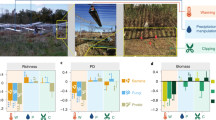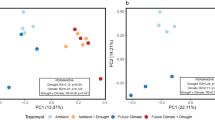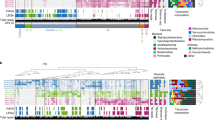Abstract
The soil microbiome is responsible for mediating key ecological processes; however, little is known about its sensitivity to climate change. Observed increases in global temperatures and alteration to rainfall patterns, due to anthropogenic release of greenhouse gases, will likely have a strong influence on soil microbial communities and ultimately the ecosystem services they provide. Therefore, it is vital to understand how soil microbial communities will respond to future climate change scenarios. To this end, we surveyed the abundance, diversity and structure of microbial communities over a 2-year period from a long-term in situ warming experiment that experienced a moderate natural drought. We found the warming treatment and soil water budgets strongly influence bacterial population size and diversity. In normal precipitation years, the warming treatment significantly increased microbial population size 40–150% but decreased diversity and significantly changed the composition of the community when compared with the unwarmed controls. However during drought conditions, the warming treatment significantly reduced soil moisture thereby creating unfavorable growth conditions that led to a 50–80% reduction in the microbial population size when compared with the control. Warmed plots also saw an increase in species richness, diversity and evenness; however, community composition was unaffected suggesting that few phylotypes may be active under these stressful conditions. Our results indicate that under warmed conditions, ecosystem water budget regulates the abundance and diversity of microbial populations and that rainfall timing is critical at the onset of drought for sustaining microbial populations.
Similar content being viewed by others
Log in or create a free account to read this content
Gain free access to this article, as well as selected content from this journal and more on nature.com
or
Accession codes
References
Bardgett RD, Freeman C, Ostle NJ . (2008). Microbial contributions to climate change through carbon cycle feedbacks. ISME J 2: 805–814.
Belay-Tedla A, Zhou X, Su B, Wan S, Luo Y . (2009). Labile, recalcitrant, and microbial carbon and nitrogen pools of a tallgrass prairie soil in the US Great Plains subjected to experimental warming and clipping. Soil Biol Biochem 41: 110–116.
Bennett AF, Lenski RE . (1993). Evolutionary adaptation to temperature II. Thermal niches of experimental lines of Escherichia coli. Evolution 47: 1–12.
Bradford MA, Davies CA, Frey SD, Maddox TR, Melillo JM, Mohan JE et al. (2008). Thermal adaptation of soil microbial respiration to elevated temperature. Ecol Lett 11: 1316–1327.
Castro HF, Classen AT, Austin EE, Norby RJ, Schadt CW . (2010). Soil microbial community responses to multiple experimental climate change drivers. Appl Environ Microbiol 76: 999–1007.
Cruz-Martinez K, Suttle KB, Brodie EL, Power ME, Andersen GL, Banfield JF . (2009). Despite strong seasonal responses, soil microbial consortia are more resilient to long-term changes in rainfall than overlying grassland. ISME J 3: 738–744.
DeSantis TZ, Hugenholtz P, Keller K, Brodie EL, Larsen N, Piceno YM . (2006a). NAST: a multiple sequence alignment server for comparative analysis of 16S rRNA genes. Nucleic Acids Res 34: W394–W399.
DeSantis TZ, Hugenholtz P, Larsen N, Rojas M, Brodie EL, Keller K . (2006b). Greengenes, a chimera-checked 16S rRNA gene database and workbench compatible with ARB. Appl Environ Microbiol 72: 5069–5072.
Elshahed MS, Youssef NH, Spain AM, Sheik C, Najar FZ, Sukharnikov LO . (2008). Novelty and uniqueness patterns of rare members of the soil biosphere. Appl Environ Microbiol 74: 5422–5428.
Fierer N, Jackson JA, Vilgalys R, Jackson RB . (2005). Assessment of soil microbial community structure by use of taxon-specific quantitative PCR assays. Appl Environ Microbiol 71: 4117–4120.
Fierer N, Schimel JP, Holden PA . (2003). Influence of drying–rewetting frequency on soil bacterial community structure. Microb Ecol 45: 63–71.
Fulthorpe RR, Roesch LF, Riva A, Triplett EW . (2008). Distantly sampled soils carry few species in common. ISME J 2: 901–910.
Garten C, Classen A, Norby R . (2009). Soil moisture surpasses elevated CO2 and temperature as a control on soil carbon dynamics in a multi-factor climate change experiment. Plant Soil 319: 85–94.
Goodfellow M, Williams ST . (1983). Ecology of Actinomycetes. Annu Rev Microbiol 37: 189–216.
Hamady M, Lozupone C, Knight R . (2009). Fast UniFrac: facilitating high-throughput phylogenetic analyses of microbial communities including analysis of pyrosequencing and PhyloChip data. ISME J 4: 17–27.
Hedlund BP, Gosink JJ, Staley JT . (1997). Verrucomicrobia div. nov., a new division of the Bacteria containing three new species of Prosthecobacter. Antonie van Leeuwenhoek 72: 29–38.
Johnson SC . (1967). Hierarchical clustering schemes. Psychometrika 32: 241–254.
Jones SE, Lennon JT . (2010). Dormancy contributes to the maintenance of microbial diversity. Proc Natl Acad Sci USA 107: 5881–5886.
Keiblinger KM, Hall EK, Wanek W, Szukics U, Hämmerle I, Ellersdorfer G et al. (2010). The effect of resource quantity and resource stoichiometry on microbial carbon-use-efficiency. FEMS Microbiol Ecol 73: 430–440.
Knapp AK, Beier C, Briske DD, Classen AeT, Luo Y, Reichstein M et al. (2008). Consequences of more extreme precipitation regimes for terrestrial ecosystems. BioScience 58: 811–821.
Konneke M, Bernhard AE, de la Torre JR, Walker CB, Waterbury JB, Stahl DA . (2005). Isolation of an autotrophic ammonia-oxidizing marine archaeon. Nature 437: 543–546.
Liu C, Whittaker RJ, Ma K, Malcolm JR . (2007). Unifying and distinguishing diversity ordering methods for comparing communities. Popul Ecol 49: 89–100.
Liu W, Zhang Z, Wan S . (2009). Predominant role of water in regulating soil and microbial respiration and their responses to climate change in a semiarid grassland. Glob Change Biol 15: 184–195.
Lozupone C, Hamady M, Knight R . (2006). UniFrac—an online tool for comparing microbial community diversity in a phylogenetic context. BMC Bioinformatics 7: 371.
Lundegärdh H . (1927). Carbon dioxide evolution of soil and crop growth. Soil Sci 23: 417–453.
Luo Y . (2007). Terrestrial carbon cycle feedback to climate warming. Annu Rev Ecol Evol Syst 38: 683–712.
Luo Y, Sherry RA, Zhou X, Wan S . (2009). Terrestrial carbon-cycle feedback to climate warming: experimental evidence on plant regulation and impacts of biofuel feedstock harvest. Glob Change Biol Bioenergy 1: 62–74.
Luo Y, Wan S, Hui D . (2001). Acclimatization of soil respiration to warming in tall grass prairie. Nature 413: 622–625.
Martens-Habbena W, Berube PM, Urakawa H, de la Torre JR, Stahl DA . (2009). Ammonia oxidation kinetics determine niche separation of nitrifying Archaea and Bacteria. Nature 461: 976–979.
Martin AP . (2002). Phylogenetic approaches for describing and comparing the diversity of microbial communities. Appl Environ Microbiol 68: 3673–3682.
Parmesan C . (2006). Ecological and evolutionary responses to recent climate change. Annu Rev Ecol Evol Syst 37: 637.
Porporato A, Daly E, Rodriguez-Iturbe I . (2004). Soil water balance and ecosystem response to climate change. Am Nat 164: 625–632.
Price MN, Dehal PS, Arkin AP . (2009). FastTree: computing large minimum evolution trees with profiles instead of a distance matrix. Mol Biol Evol 26: 1641–1650.
Ratkowsky DA, Olley J, McMeekin TA, Ball A . (1982). Relationship between temperature and growth rate of bacterial cultures. J Bacteriol 149: 1–5.
Schloss PD, Westcott SL, Ryabin T, Hall JR, Hartmann M, Hollister EB et al. (2009). Introducing Mothur: open-source, platform-independent, community-supported software for describing and comparing microbial communities. Appl Environ Microbiol 75: 7537–7541.
Shaver GR, Canadell J, Chapin III FS, Gurevitch J, Henry G . (2000). Global warming and terrestrial ecosystems, a conceptual framework for analysis. BioScience 50: 871.
Wan S, Hui D, Wallace LL, Luo Y . (2005). Direct and indirect effects of experimental warming on ecosystem carbon processes in a tallgrass prairie. Glob Biogeochem Cycles 19: GB2014.
Wan S, Luo Y, Wallace LL . (2002). Changes in microclimate induced by experimental warming and clipping in tallgrass prairie. Glob Change Biol 8: 754–768.
Youssef NH, Elshahed MS . (2008). Diversity rankings among bacterial lineages in soil. ISME J 3: 305–313.
Acknowledgements
We thank Dr Ed Kessler and the University of Oklahoma for access to the Kessler Farm Field Laboratory, Jessica Sieber for editorial assistance and Dr Boris Wawrik and Dr Liz Karr for use of lab equipment. This work was supported by the National Science Foundation Microbial Observatories Program (Grant EF0801858) and the National Academy of Sciences (Grant PGA P280292). Sequence Data: Pyrosequencing data can be accessed through Genbank Sequence Read Archive accession number SRA11007.
Author information
Authors and Affiliations
Corresponding author
Additional information
Supplementary Information accompanies the paper on The ISME Journal website
Supplementary information
Rights and permissions
About this article
Cite this article
Sheik, C., Beasley, W., Elshahed, M. et al. Effect of warming and drought on grassland microbial communities. ISME J 5, 1692–1700 (2011). https://doi.org/10.1038/ismej.2011.32
Received:
Revised:
Accepted:
Published:
Issue date:
DOI: https://doi.org/10.1038/ismej.2011.32
Keywords
This article is cited by
-
Nitrogen deposition mediates more stochastic processes in structuring plant community than soil microbial community in the Eurasian steppe
Science China Life Sciences (2024)
-
Seasonal precipitation and soil microbial community influence plant growth response to warming and N addition in a desert steppe
Plant and Soil (2023)
-
Unboxing the black box—one step forward to understand the soil microbiome: A systematic review
Microbial Ecology (2023)
-
Microbial diversity and ecological interactions of microorganisms in the mangrove ecosystem: Threats, vulnerability, and adaptations
Environmental Science and Pollution Research (2022)
-
Sensitive Groups of Bacteria Dictate Microbial Functional Responses to Short-term Warming and N Input in a Semiarid Grassland
Ecosystems (2022)



